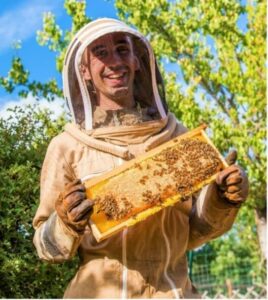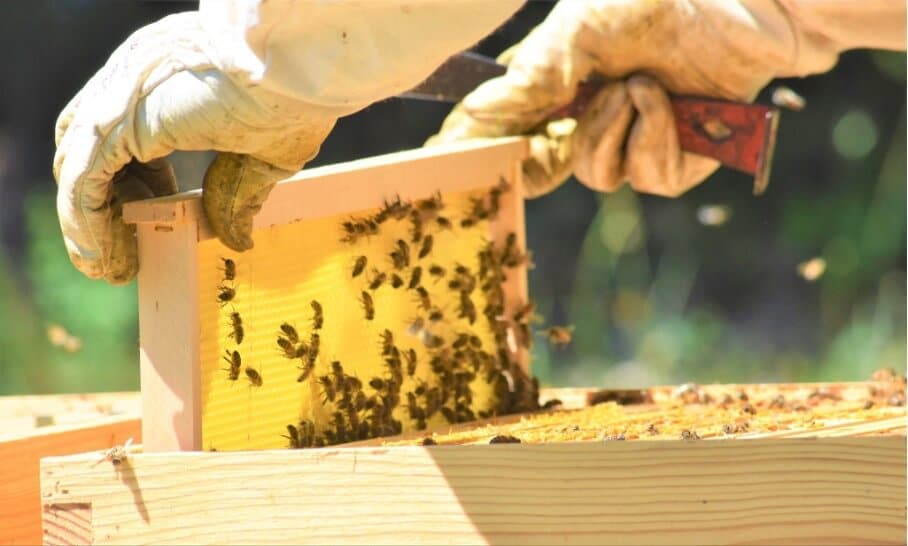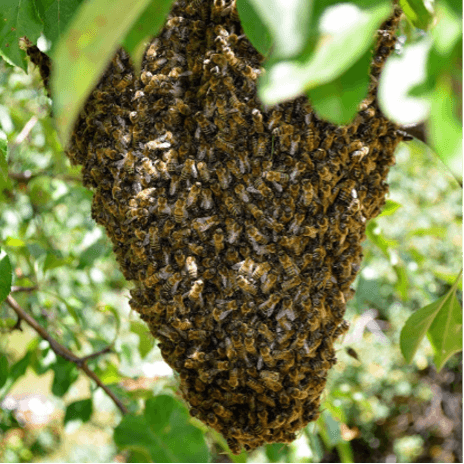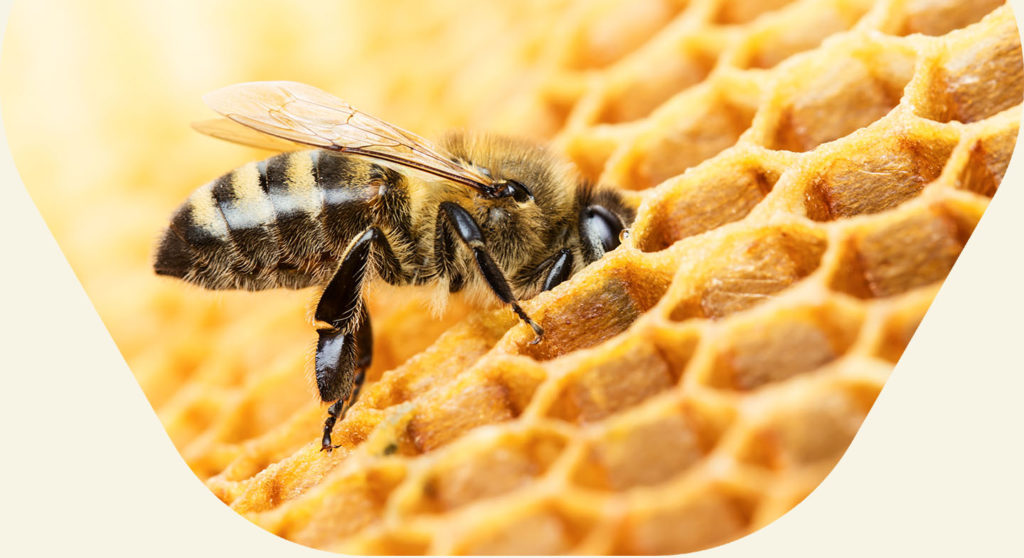API of the Month
Mathieu Domecq
Editor-in-chief of the API blog of the month
Find out what beekeeping work needs to be done in April and learn more about swarming. You will also learn how to wax your frames properly and what to do after a beehive has divided.
Did you know that bees can build up to 80,000 alveoli with 1 kg of wax! Building the honeycomb is a team effort. It takes no less than 6 hours and the work of a hundred bees to make a single alveolus! (Source: Secret de miel)
This month’s work

April is a busy month for beekeepers. There is so much to do and keep an eye on. The more beehives you have, the more you are rushed off your feet… Here is a summary of the beekeeping work:
– Enlarge the colonies: for swarms that were partitioned during the winter (isolating frame), it is time to enlarge the space by removing the partition and replacing it with waxed frames. The queen needs space. Always position your new frames between the brood frames and feed frames (honey and pollen) on each side of the hive. You can stimulate the colony by pouring a little Apiinvert syrup into the feeder.

– Fit supers: if the body is full (or almost full), consider fitting a super. Especially if your area consists of rapeseed, hawthorn, clover, etc. it will soon overflow. There is a risk that the queen will not have any room to lay as the foragers will have filled all the space with honey. The super sits above the body. Some beekeepers use a queen excluder. Personally, I do not use one because it can accelerate swarming. On the other hand, as its name suggests, the queen excluder prevents her climbing into the super to lay which damages the frames due to the presence of brood. You should only place the super when the body is completely full.
– Divide the colonies: if your brood consists of more than 7 or 8 frames in a Dadant 10-frame beehive, there is a risk of swarming. Even with a super in place, a few frames need to be replaced with new ones. Take an empty beehive and create a swarm. There are many ways of doing this. The easiest is to place a closed brood frame (nymphs), an open brood frame (eggs and larvae) and a reserve frame (honey and pollen) with bees. I avoid taking the queen. Then keep this closed beehive isolated for 48 hours, or move it over 3 km away before opening it. A queen farm will then start to be established.
– Harvesting swarms: with swarming in certain beehives, you may come across clusters of bees on branches. You must collect them by making them fall into a small beehive. This period will run from early April to mid-May.
– Trapping queen hornets: installing a trap can prove effective. In this period, you will be catching the queens.
The honey flowers of the month: rapeseed, thyme, clover, rosemary and dandelion.
Waxing frames
This is a step that beekeepers must master. Assembling your frames correctly means making sure that the wax holds, especially on the super frames in high summer heat. If they are not assembled correctly, they may collapse into the body of the beehive.
How do you wax a frame? Use a wired frame, preferably in a vertical position. You will need a frame-sized wax sheet, a frame wire tensioner and a 24 volt transformer. Start by re-tensioning the wires with the wire tensioner. This will give it an undulation and enable the sheet to hold better by hugging the shape of the alveoli. Then place your sheet in the groove at the top of the frame. This will avoid the need to melt wax to weld the sheet to the frame as suggested by some of the literature.
Using the transformer, you will pass the electricity from one end of the wire going through the frame to the other. When heated, the wax will melt and the wire will begin to appear. Stop at the right time to avoid cutting the sheet into small pieces. The aim is to slightly heat the wires so that they can be held in the middle of the embossed wax sheet. This means that when you shake your frame, the sheet stays in place and you can use it.

Has my swarm just swarmed?
You have just seen your swarm fly from the beehive to a nearby branch? Yes, this can happen! The swarming season is upon us. But what should we do?
Let us start by talking about the swarm on the branch. Get hold of a small beehive with waxed (or well-built) frames. Place this small beehive under the cluster, emptying its frames to begin with. Grab the branch and shake it roughly so that the bees fall into it. Then reposition the frames in the beehive, then put on the frame cover and the roof. Leave the entrance of this beehive open and keep it on the ground, near this branch, for a few hours. The other foragers will continue to go round and round and then calm down. They will all be back in the beehive when it gets dark. You can then take it and place it on your beehive.
The original hive that swarmed is now orphaned; but rest assured, nature finds a way and the bees intend to raise new queens. We talk about new queens in the plural, because for safety, around a dozen eggs will be bred as queens at the time of swarming. Hatching is approaching and it takes 16 days for a queen to be born (from egg to nymph). So when swarming takes place, the new queens should be born within a few hours. You can open your beehive one week after the swarm to check for the arrival of this new queen. You may not see any eggs or larvae initially because it is still too early. They need to be fertilised first and, depending on the weather, this may take a few days. Once in place, this queen will give rise to 2,000 births per day and the first bees laid are seen 21 days after fertilisation.
A virgin queen is a little lost at birth, and if you open the beehive at that time it may fly outside. Trust me, I know from experience! It is better to avoid this. When a lot of eggs are laid and the population is growing, consider positioning a super if you have not already done so; or a second one if it is full.
Why a swarm? Usually because the queen lacks space. Since there are no longer any free alveoli, she leaves with half of the beehive population to find shelter elsewhere. If you have rapeseed nearby, this plant is said to create “swarm fever”. The colony fills the space of the beehive (body and super) so quickly due to the abundance of honey that this leads to the natural division of the species.

A bit of biology
Novice beekeepers should have some knowledge of bee biology. Indeed, to understand swarming, hive repopulation or the raising of a queen, you need to know some of the stages. First, locate an egg.
An egg is like a small white thread at the bottom of the alveolus. It is about 2 mm long. If you see one, this confirms the presence of a queen… It will remain in this form for 3 days. After this time, the egg will turn into a larva. The larval stage lasts 6 days; on day 9 the nymph stage begins. This is when the larva turns into a bee. This stage is not visible in the beehive because the alveolus is then closed by the bees. This nymphatic stage will last 12 days. The bee will then be born, having taken 21 days.
The stage of the egg and the larva is exactly the same for a queen and a drone. The nymph stage will be shorter for the queen (7 days) and longer for the male (15 days).

As usual, share your photos with us. We will publish them on our website from social media with the hashtags #apifonda #apiinvert!
We will be back next month on the API blog with your faithful partner, Les Ruchers De Mathieu!

LES RUCHERS DE MATHIEU
Honey & Beekeeping Shop
Photos ©lesruchersdemathieu


